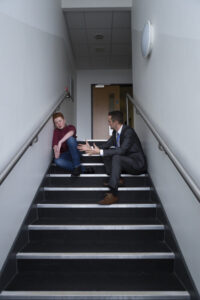The Formula to Understand and Treat Trauma
90% of patients and clients receiving behavioral health care have experienced trauma. With such an alarming number, it is evident trauma is something we ought to talk about and fully understand and address. Let’s start with the most scientifically methodical process possible, for which inquiry will be best suited. Let us begin with the term or concept of “Trauma.”
What is trauma? What does this concept entail? What does it evoke? And what types of associations come to mind when we hear this term? Furthermore, what types of beliefs, however limiting, might exist about trauma? Why do we have so many people in the field of mental health who have experienced trauma? And more importantly, why is our success with treating individuals with trauma so minimal? What are we missing?
Several experts in the field explain that the concept of trauma is used to illustrate “what takes place when a person is overwhelmed by events or circumstances and responds with intense fear, horror, and helplessness…. In this case, extreme stress overwhelms the person’s capacity to cope…[1]”
The conceptualization of “trauma” provides us with many clues to a deeper understanding and much more effective treatment of trauma if we are willing to take a more in-depth look. Let us proceed accordingly:
From the above conceptualization of trauma, we gather the following insight:
-
Trauma takes place when a person is overwhelmed by events or circumstances. There is a lot to learn from this, and we will cite only the following:
a. Just like it shows in CBT, the events or the circumstances are not “overwhelming,” in and of themselves, rather the person is the one who gets overwhelmed. This, of course, is proven by the fact that not everyone experiencing the same type of event or circumstance, become overwhelmed and develop symptoms of PTSD. One of the most famous examples is the Jewish therapist, Viktor Frankl, who was held in a Nazis Concentration Camp during the Second World War. In his book, Man’s Search for Meaning, he explains how he managed to be at his best while others including colleagues and family members were suffering. He also explains how he could easily predict, from the very beginning, who was likely to suffer.
b. Perception is key. If some people are overwhelmed, suffer, or develop symptoms of PTSD, while others are not or do not, even after accounting for genetic and environmental factors, then there is more here than meets the eye. It’s perception. Perception is how we look at the event, and it dictates the type of meaning we give to the event, which then determines whether we get overwhelmed or not, and whether we suffer or not
c. Focus is the vehicle. The type of meaning that we assign to the event determines whether we focus on it or not and how we focus on it. This, in turn, leads to a series of associated thoughts that reinforce the focused thought, enhancing its effects
d. Feeling overwhelmed comes from our thoughts about the event and not from the event itself. In other words, we feel our thoughts and not the events. And just as the field of CBT clearly puts it, our perception about a situation and not the situation itself determines the feelings and behaviors that follow. What CBT is trying to communicate here is that all events are neutral and no event is traumatic in and of itself, rather, our thoughts about the event, in the form of perception, meaning, focus, and associated thoughts, will determine our reaction to such an event, which is the determining factor to the manifestation of symptoms.
e. Our meaning comes from our perception and our perception comes from our attitude. In other words, what we perceive is how we look at things, which comes from our attitude, which, in turn, is where we are looking from, where we are coming from, and the perspective from which we are looking. This then means, if perception is key in who gets overwhelmed and develops trauma in response to an event, then our attitude, which is our perspective on life, on ourselves, on others, on the past, and on the future, must be the Decisive Factor.
f. Our attitude comes from our beliefs. This means our beliefs are the Operant Factor since from it derives our attitude, which is the decisive factor, and from which, in turn, derives our perception, which is the Key Factor, from which the meaning we assign to the event derives.
2. “…and responds with intense fear, horror, and helplessness….[1]” This is the second part of the conceptualizing statement of trauma, and the key word here responds. To respond entails the ability to do so, and the ability to respond is conceptualized as responsibility. Responsibility does not mean blame, rather, it means choice. The choice to respond and the choice to choose how to respond. This is where attitude comes in, this is where attitude becomes the decisive factor, and since our attitude is highly influenced by our belief, whether we respond or not, or how we respond is informed by our belief system. Therefore, for a higher understanding and more effective treatment, we ought to take a closer look at our beliefs.
A belief is a thought that has been practiced regularly, frequently, and intensely and which has become automatic, reflexive, and buried in the unconscious mind. This means, once a thought has become a belief, we may stop being as conscious of it, yet, it is conducting and operating every aspect of our life.
For the sake of better operationalizing, our beliefs can be categorized in the following ways:
-
Beliefs about ourselves
-
Beliefs about how others view us
-
Beliefs about the past
-
Beliefs about the future
-
Beliefs about the world
-
Beliefs about others
-
Beliefs about our coping mechanisms
Given how crucial this is, let’s look at the first two of them:

Beliefs about ourselves:
When it comes to events, our beliefs about ourselves will make a big difference. For example, if we believe we are unworthy, undeserving, or are not likely to be “dealt a good card by life” then our response to an event is likely to be different than if our belief about ourselves is one of worthiness, reflected by a healthy self-image, self-concept, and self-efficacy.
For example, in relationships, it may matter little how much someone may love us if our belief about ourselves is one of unloved, or unlovable or unloving. As such, a situation involving someone who loves us is likely to be interpreted through the lens of being unlovable as long as such beliefs about ourselves remain.
It should be evident that those who are more likely to become overwhelmed by an event or a circumstance and respond with intense fear, terror, and helplessness, are more likely to have shown beliefs about themselves that are not serving them. Here is a list of examples of such beliefs:
-
I am not worthy or I am unworthy
-
I am not lovable
-
I have done lots of things that deserve punishment
-
I am an embarrassment
-
I am a shame to my family
-
I am a disgrace to my community or my profession
-
I don’t deserve to be here
-
I always screw up things
-
I am ugly
-
I always let people down
-
I am too old
-
I was made to be unhappy
-
I just have bad luck
-
I don’t trust myself
-
I was not made to succeed
As you take some time and ponder upon each of the above fifteen examples of the types of beliefs those who are more prone to display symptoms of trauma, let us move one to the second category of belief, which is:
Beliefs about how others view us:
William Thackeray astutely said, “The world is a looking glass and gives back to every man the reflection of his own face.” This piece of knowledge has been represented in every one of the major five models of thought, attempting to make sense of who we are, our nature, what our life is all about, and what does it mean to be a human being. These five types of models of thought are; Science, Philosophy, Metaphysics, Spirituality, and Religion. All five models speak to the subjectivity principle as the mechanism for our perception. All five show evidence for how our world is but our looking glass. In other words, we live in a world of projection, which means, we think it about ourselves, and we put it out there, and/or it gets reflected back to us. Some people may find this a bit disconcerting, while many others may find it to be rather empowering. One thing for sure is that we project and people respond accordingly, and we wish people to view us differently, we ought to start projecting differently, better yet, extend instead of projecting.

Here is a list of examples of beliefs about how others view us:
-
People don’t like me
-
People don’t like to talk to me
-
People don’t like to be around me
-
People find me annoying
-
People find me too talkative
-
People are my friends only because they pity me
-
People are with me because they feel obligated to
-
People are with me because of guilt
-
People find me ugly but they’re just not telling me the Truth
-
People are just not telling me the truth because they don’t want to hurt me
-
People are just being nice to me but they don’t really mean it
-
People are just being kind to me
These types of beliefs tend to lead to self-sabotaging behaviors, which lends itself to an intensified process of projection. It is also accompanied by limited trust, leading to the perception of events and circumstances through such a lens, leading to a likelihood of feeling overwhelmed by events or circumstances and respond with intense fear, horror, and helplessness…
Given the high number of individuals with symptoms of PTSD or trauma reactivity, it seems to follow logic to say that a proper understanding of trauma and an effective treatment thereof can come only with the incorporation of the above paradigm. A paradigm that gets replicated and provides the same results, all the time, and one that can be summarized through the following points:
-
We do not feel things, events, circumstances, or experiences, rather, we feel our thoughts about them.
-
Our thoughts can influence our feelings only when focused upon, and focus denotes what we are looking at
-
What we are looking at varies based on which meaning we assign at any given time to the same event, circumstance, or experience
-
The type of meaning we assigned is designed by our perception, which is the how of looking at things
-
How we are looking at things (our perception) derives from our attitude, which is where we are looking at things from
-
Where we are looking at things from or our attitude, emanates from our beliefs
-
Our beliefs, therefore, are the Operant Factor in the mechanism of symptom formation in trauma, while our attitude is the Decisive Factor, given our natural ability to shift perspectives when we know how; And our feelings, on the other hands, are that Intelligent Factor that bridges our internal and our external world, allowing us the ability to experience even that which we would not be conscious of, and then to choose a different one.
A deep understanding of trauma and an effective treatment thereof can be made possible with the mastery of the above expose. As clinicians seeking to make a difference and cease suffering, we have the duty to access the latest of what is available to help our patients and clients heal from their current trauma and prevent new ones. For, as Einstein says, “We cannot solve our problems with the same thinking we used when we created them.”
Do you want to help your patients and clients heal from trauma once and for all? If so know that the truths outlined above when implemented well can set them free.
If you want the master the implementation steps of the above, feel free to join us for our full-day webinar on Trauma, scheduled for December 11, 2020, 9am-5pm, where you will also get to earn 6 CEUs, while mastering an essential skill.
We look forward to seeing and welcoming you then!
Karen and Mardoche
[1] Institute of Medicine (US) Committee on Responding to the Psychological Consequences of Terrorism; Stith Butler A, Panzer AM, Goldfrank LR, editors. Preparing for the Psychological Consequences of Terrorism: A Public Health Strategy. Washington (DC): National Academies Press (US); 2003. 2, Understanding the Psychological Consequences of Traumatic Events, Disasters, and Terrorism.
About the Authors:
Karen Dubin-McKnight, PhD, LCSW, is a Columbia-trained Social Worker with wide clinical, teaching, and supervision experience. She also has a background in management, mentorship, and leadership that spans almost 20 years. Her added passion is in advocacy, coaching, public relations, and mediation. Her goal is to ensure that social workers and women feel empowered and have a voice “at the table.” She has previously held Executive level positions, and two other directorships in different organizations. She is currently Adjunct Faculty at Columbia University School of Social Work and Adelphi University School of Social Work. She also maintains a private practice, working with individuals who have experienced loss and trauma, and also provides clinical and management supervision.
Mardoche Sidor, MD is a Harvard-trained Quadruple Board Certified Psychiatrist, Assistant Professor of Psychiatry at Columbia University, School of Physicians and Surgeons. He is trained in and taught all the major psychotherapeutic modalities, including and not limiting to CBT, DBT, Family Systems, and Psychodynamic Psychotherapy. He is also the author of 3 books including Journey to Empowerment; Discovering Your Worth; and The Power of Faith. Dr. Sidor has worked both as a primary care physician and as Medical director in three different settings, including as Chief Medical Officer of Center for Alternative Sentencing and Employment Services (CASES). He is the Founder and CEO of the SWEET Institute.









